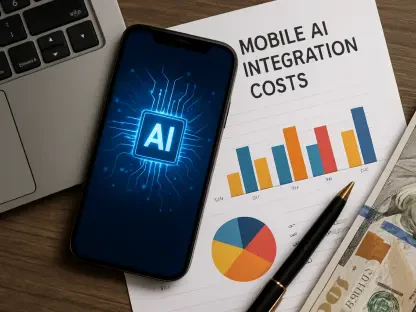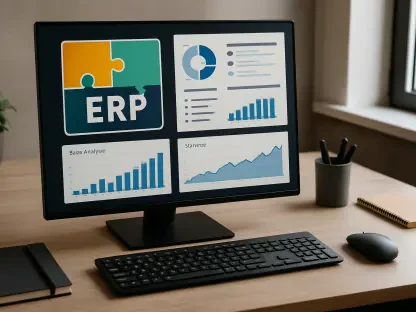In today’s fast-paced digital economy, businesses must constantly innovate to stay relevant and competitive. Application modernization is key to achieving this, transforming outdated IT infrastructures into agile, scalable, and secure systems capable of meeting ever-evolving business goals and market demands.
Continuous Commitment to Modernization
Iterative and Evolving Process
Application modernization should not be viewed as a one-time project. Instead, it is an ongoing commitment to continuous improvement. Legacy systems often impede the consistent delivery of value, necessitating a strategic shift toward iterative and evolving modernization efforts. Businesses that prioritize continuous modernization maintain a competitive edge by regularly updating their IT infrastructures to align with current technologies and market dynamics. This approach allows them to swiftly adapt to changes, thereby avoiding potential disruptions that static, outdated systems might cause.
Implementing an iterative modernization process means constantly evaluating and refining applications to ensure they meet contemporary standards. This approach involves incremental updates rather than large-scale overhauls, which can be disruptive. By adopting an evolving process, organizations can integrate small, manageable changes that collectively result in significant improvements. Continuous feedback from users and stakeholders plays a crucial role in this strategy, providing insights into necessary enhancements and identifying potential issues before they escalate. Consequently, businesses can maintain momentum in their modernization journey, ensuring consistent value delivery.
Embracing Innovation
Modernization efforts allow businesses to embrace the latest technological innovations, ensuring they remain at the forefront of their industry. By continuously updating and refining applications, companies can respond to new opportunities and challenges effectively. Embracing innovation involves integrating emerging technologies such as artificial intelligence, machine learning, and edge computing into the modernization strategy. These technologies not only enhance operational efficiency but also open up new avenues for growth and customer engagement.
Innovation is also fostered through the adoption of agile development methodologies, which promote rapid prototyping and iterative enhancements. This allows businesses to experiment with new features and functionalities, gaining insights from real-world usage to inform further refinements. By staying attuned to technological advancements, companies can leverage innovative solutions to streamline processes, improve user experiences, and stay competitive. Embracing a culture of innovation ensures that modernization initiatives are proactive rather than reactive, positioning businesses to capitalize on emerging trends and maintain their edge in a dynamic market environment.
Benefits of Modernization
Business Agility and User Experience
Modernized applications provide the agility needed to rapidly adapt to changes in the market, technology, and customer expectations. Enhanced user experiences are another significant benefit, as modern applications can offer seamless, intuitive, and personalized interactions that legacy applications cannot. The agility afforded by modernization empowers businesses to quickly pivot strategies in response to market shifts, enabling them to seize new opportunities and address challenges efficiently. This responsiveness is crucial in a competitive landscape where customer needs and technological advancements evolve rapidly.
Improving user experience through modernization is paramount for customer satisfaction and retention. Modern applications are designed with user-centric principles, ensuring they are intuitive, responsive, and aesthetically pleasing. Personalization is another key feature of modernized applications, allowing businesses to tailor interactions based on individual preferences and behaviors. By delivering a superior user experience, companies can foster customer loyalty, enhance brand reputation, and drive long-term growth. This focus on user-centric design underscores the importance of modernization as a means to create applications that meet, or exceed, modern-day expectations.
Cost Optimization and Future-Proofing
Moving to scalable cloud resources helps optimize costs by reducing maintenance expenses and leveraging pay-as-you-go models. Additionally, modernized applications can integrate emerging technologies like AI and edge computing, ensuring businesses are well-positioned for future advancements. Cost optimization through cloud adoption not only reduces the financial burden associated with maintaining on-premises infrastructure but also provides flexibility to scale resources based on demand. This elasticity ensures that businesses pay only for the resources they use, optimizing expenditure and enhancing operational efficiency.
Future-proofing is a crucial aspect of modernization, as it prepares businesses to adapt to upcoming technological trends and market demands. Integrating AI and edge computing into applications enables businesses to harness real-time data processing capabilities, improving decision-making and operational agility. These technologies also support the development of intelligent applications that can automate processes, analyze vast datasets, and provide actionable insights. By future-proofing their IT infrastructure, businesses can maintain a competitive edge, ensuring they are not only ready for current challenges but also well-equipped to tackle those on the horizon.
Strategic Assessment and Planning
Application Landscape Audit
The modernization journey begins with a comprehensive audit of existing applications. This involves categorizing them based on factors such as business criticality, technical debt, and alignment with strategic goals. This assessment helps prioritize modernization efforts effectively. Conducting an application landscape audit provides a clear understanding of which applications are most critical to business operations and which ones incur significant technical debt. By evaluating these factors, businesses can identify high-priority applications that require immediate attention and allocate resources efficiently.
An effective audit involves collaborating with stakeholders across the organization to gather insights and understand the broader business context. This ensures that the modernization strategy aligns with organizational objectives and addresses the needs of different departments. The audit should also consider external factors such as regulatory requirements and industry standards, ensuring that modernization efforts comply with relevant guidelines. By conducting a thorough audit, businesses can create a prioritized roadmap for modernization that optimally utilizes resources and maximizes impact.
The “6 Rs” Framework
Using the “6 Rs” framework — rehost, replatform, refactor, rearchitect, rebuild, and replace — businesses can determine the most appropriate modernization strategy for each application. This structured approach ensures resources are allocated efficiently and modernization efforts are strategically aligned. The 6 Rs framework offers a systematic way to evaluate and plan modernization strategies, ensuring that each application’s unique requirements and constraints are considered.
Rehosting, or lifting and shifting applications to the cloud, is often the quickest way to migrate legacy applications without significant changes. Replatforming involves making optimizations to take advantage of cloud benefits, while refactoring requires substantially modifying the application’s code to improve functionality and scalability. Rearchitecting involves redesigning the application’s architecture for better performance and maintenance, while rebuilding entails developing the application from scratch using modern technologies. Finally, replacing involves completely discarding the old application in favor of a new, off-the-shelf solution. This comprehensive framework ensures that each application is modernized in a manner that best suits its operational needs and strategic importance.
Cloud-First Strategy
Transitioning to Cloud-Native Architectures
A cloud-first strategy is central to application modernization, involving the migration to cloud-native architectures. This transition enables businesses to leverage the scalability, flexibility, and cost benefits of cloud resources from providers like AWS, Azure, and Google Cloud. Adopting a cloud-native approach means designing applications to take full advantage of cloud services, allowing for rapid scaling based on demand and improved resource utilization. This approach also reduces reliance on physical infrastructure, mitigating risks associated with hardware failures and maintenance.
Transitioning to cloud-native architectures involves re-engineering applications to use microservices, containers, and serverless computing, which enhances modularity and reduces deployment complexities. Microservices architecture allows component isolation and independent scaling, thereby increasing application resilience. Containers, managed by orchestration platforms like Kubernetes, provide consistent deployment environments and streamline the development process. By moving to cloud-native architectures, businesses can achieve higher levels of agility, enabling them to respond swiftly to market changes and customer demands while minimizing costs.
Avoiding Vendor Lock-In
To maintain flexibility, businesses should adopt cloud-agnostic architectures and platforms that support multicloud operations. Tools like Kubernetes facilitate this approach, preventing dependency on a single cloud vendor and enabling optimal resource utilization. Avoiding vendor lock-in is crucial for maintaining operational flexibility and negotiating better terms with service providers. By adopting cloud-agnostic solutions, businesses can seamlessly migrate workloads between different cloud environments or utilize multiple cloud services based on specific needs and cost advantages.
Cloud-agnostic architectures involve designing applications to be portable across various cloud environments, ensuring compatibility with different platforms and services. This approach empowers businesses to leverage the best features of multiple cloud providers, optimizing performance and cost-efficiency. Additionally, using tools like Kubernetes for container orchestration enhances resource management and scalability, enabling businesses to manage applications consistently across different cloud environments. By adopting a multi-cloud strategy, businesses can mitigate risks associated with vendor lock-in, ensuring they can adapt to changing requirements and leverage the full potential of cloud computing.
Microservices and API-Driven Architectures
Shifting from Monolithic to Microservices
A critical aspect of modernization is transitioning from monolithic architectures to microservices. This shift enhances application agility and resilience, allowing for independent development and deployment of application components. Microservices architecture decomposes applications into smaller, loosely coupled services that can be developed, deployed, and scaled independently. This enhances flexibility, as each microservice can be managed and updated without affecting the entire application. As a result, businesses can accelerate development cycles, reduce downtime, and improve overall application performance.
Implementing microservices requires adopting practices such as containerization, which encapsulates microservices in isolated environments, ensuring consistency across different deployment stages. Tools like Docker and Kubernetes play a vital role in managing these containers, providing orchestration and scalability. By leveraging containerization, businesses can achieve efficient resource utilization and streamline the deployment process. Transitioning to microservices also promotes continuous integration and continuous delivery (CI/CD) practices, enabling frequent and reliable application updates. This iterative development approach ensures that applications remain agile and resilient, capable of adapting to evolving business needs.
Integration Through APIs
APIs play a crucial role in modernizing applications by enabling seamless integration with third-party tools and services. This API-driven approach ensures that modernized applications can easily interact with external systems and extend their functionality. By exposing application functionalities through APIs, businesses can create modular and interoperable systems, facilitating easier integration and collaboration. This approach also enables the reuse of functionalities across different applications, enhancing development efficiency and reducing duplication of efforts.
API management platforms provide tools for designing, publishing, and monitoring APIs, ensuring they are secure, scalable, and compliant with industry standards. Effective API management involves implementing best practices such as versioning, throttling, and access controls to ensure reliable and secure interactions. By adopting an API-driven architecture, businesses can create a flexible and extensible ecosystem, enabling rapid innovation and integration with new technologies. This approach also supports the development of ecosystem partnerships, where businesses can collaborate and integrate with other service providers to deliver comprehensive solutions for their customers.
Security and Compliance
Integrating Security at Every Stage
Security is integral to every phase of the modernization process. Adopting best practices such as Shift-Left Security and Zero-Trust Architecture ensures robust protection against vulnerabilities while maintaining compliance with evolving data privacy regulations. Shift-Left Security emphasizes integrating security considerations early in the development lifecycle, ensuring potential issues are addressed proactively. This involves conducting regular security assessments, code reviews, and vulnerability scanning to identify and mitigate risks before they become critical.
Zero-Trust Architecture assumes that threats can exist both inside and outside the network, requiring strict verification of users and devices trying to access resources. This approach involves implementing strong authentication, authorization, and continuous monitoring mechanisms to establish a trusted environment. By incorporating these security best practices, businesses can create a robust security posture that mitigates risks and ensures compliance with regulatory requirements. Integrating security at every stage of modernization not only safeguards sensitive data but also builds customer trust and confidence.
Key Security Areas
Modernization efforts must encompass the protection of APIs, enforcement of strict access controls, and data encryption. These measures collectively safeguard the integrity and confidentiality of applications and sensitive data. Protecting APIs involves implementing robust authentication and authorization mechanisms to ensure that only authorized users and systems can interact with them. This includes using techniques such as OAuth and API gateways to manage and secure API access.
Strict access controls are essential for ensuring that sensitive data and resources are only accessible to authorized individuals. This involves implementing role-based access control (RBAC) and multifactor authentication (MFA) to enhance security. Data encryption, both at rest and in transit, is another critical security measure that protects sensitive information from unauthorized access and breaches. Using strong encryption algorithms and key management practices ensures that data remains confidential and integral throughout its lifecycle. By focusing on these key security areas, businesses can ensure that their modernization efforts are secure and compliant with industry standards and regulations.
Cultivating a DevOps Culture
Collaboration and Automation
Successful modernization requires a cultural shift toward DevOps, fostering collaboration among development, operations, and business teams. Automating build and deployment pipelines using tools like Jenkins and GitHub Actions streamlines processes and enhances efficiency. DevOps culture emphasizes breaking down silos between teams, promoting cross-functional collaboration, and aligning efforts toward common goals. This approach enables faster delivery of high-quality applications, as development and operations teams work together seamlessly to identify and resolve issues.
Automation is a cornerstone of DevOps practices, reducing manual intervention and increasing consistency and reliability. By automating build, test, and deployment processes, businesses can accelerate release cycles and ensure that applications are developed and deployed in a standardized manner. Tools like Jenkins, GitHub Actions, and other CI/CD platforms provide robust automation capabilities, enabling continuous integration and continuous delivery. This automation not only speeds up development and deployment but also enhances quality by ensuring that code changes are thoroughly tested and validated before reaching production.
Continuous Learning and Optimization
In our fast-paced digital era, businesses must consistently innovate to stay relevant and competitive in the market. Application modernization has become a crucial aspect of this ongoing innovation, transforming outdated IT infrastructures into adaptable, scalable, and secure systems. By doing so, organizations can better meet their ever-evolving business objectives and market demands.
Modernization of applications involves updating legacy systems to more advanced, efficient, and flexible technologies. This process not only enhances performance and security but also improves agility and scalability, enabling companies to respond swiftly to market changes and new opportunities. Leveraging modern software architectures such as microservices, cloud-native solutions, and containerization, businesses can optimize resource utilization and reduce operational costs.
In essence, application modernization allows businesses to stay ahead by ensuring their IT infrastructure can support contemporary business needs and future growth. It’s an investment in an organization’s long-term success, promoting innovation and maintaining a competitive edge in the dynamic digital landscape.









